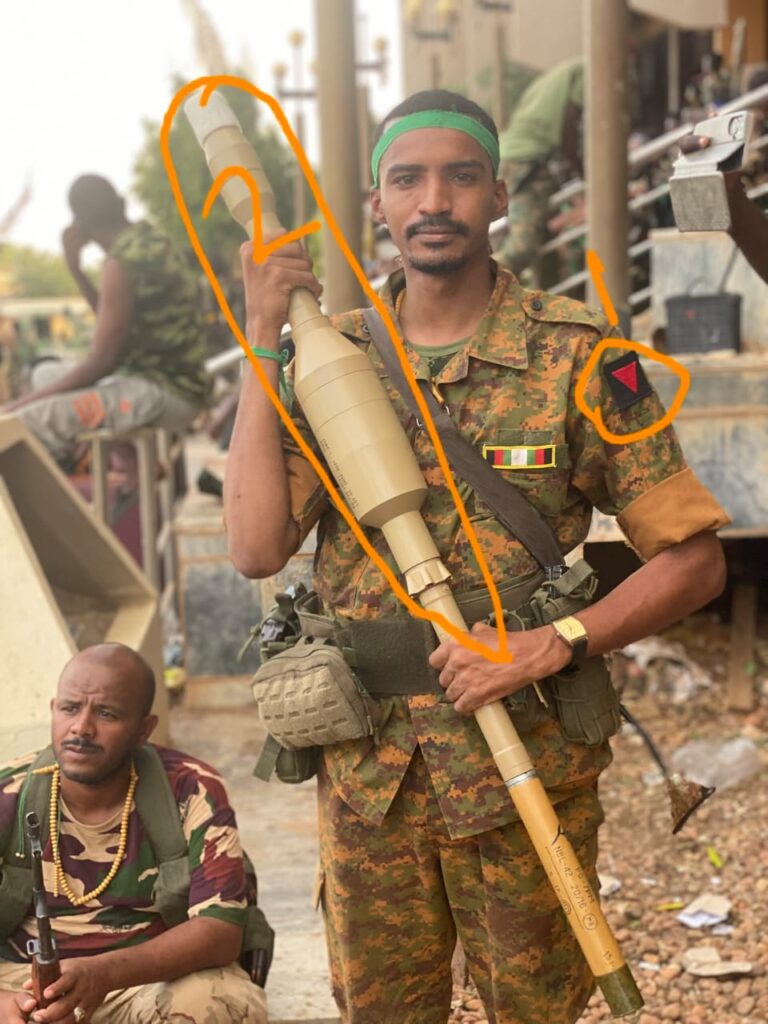(Report: Sudan Gate)
Introduction:
A picture has surfaced showing one of the Islamic militia members fighting alongside the Sudanese army, leaning against a military vehicle next to a group in military attire, holding an oddly shaped rocket in his hand. Upon closer inspection, it became clear that it is a (Yassin 105) rocket manufactured by the Al-Qassam Brigades, the military wing of the Palestinian Hamas movement.
The “Yassin 105” rocket is an altered version of the Russian “Tandem 85” rocket, characterized by its ease of use and high destructive capability. It is launched from a shoulder-mounted “RPG” launcher and is used against armored military vehicles and tanks, as well as for penetrating and destroying fortified buildings.
The “Yassin 105” rocket was widely used in the recent war launched by Hamas against Israel, as announced by its spokesperson, Abu Ubaida, in a speech on October 28, 2023.
Identity of the Rocket Holder:
After investigation, it was revealed that the individual holding the rocket is named (Al-Mudhafar Daqeel), a member of the (Al-Bara’a bin Malik) Brigade, which is a jihadist group affiliated with the Sudanese Islamic movement, fighting alongside the army against the Rapid Support Forces. It is widely believed that this group ignited the spark of war and fired the first shot on April 15, 2023.
Yesterday, Al-Mudhafar wrote on X (formerly Twitter) that following the announcement of the death of “Yahya Al-Senwar,” the leader of Hamas in Gaza, he would change his name from Al-Mudhafar Daqeel to Mudhafar Al-Senwar.
On July 1, 2024, Al-Mudhafar Daqeel wrote on the (Sudan News) website, a news outlet run by the Islamic movement that it uses for incitement and war propaganda. He wrote an article titled “Don’t Weep, But Carry Arms,” in which he stated: “The complete and fundamental goal of this war is to uproot Sudan and turn it into an agent for the petrodollar states while preserving the security of Israel and the interests of Western imperial centers, and there is no solution except for war and resistance.”
The Relationship Between the Sudanese Islamic Movement and Hamas:
The relationship between the Sudanese Islamic movement (the Brotherhood) and Hamas has a long history, characterized by military cooperation and logistical support during the presidency of Omar al-Bashir. During that time, Sudan played a crucial role in transporting Sudanese and Iranian arms to the Gaza Strip by smuggling them through Egyptian territories.
This cooperation was part of the policy of the (Sudanese Brotherhood) to support Hamas, which represents the military wing of the Muslim Brotherhood in Palestine. During that period, Sudan faced Israeli airstrikes targeting Iranian weapon factories in Sudan and arms shipments destined for Hamas, making Sudan a key transit point for smuggling weapons to Gaza.
The Return of the Previous Regime and the Resurgence of Terrorism:
A report published last Thursday, October 17, by the “Conflict Observatory,” a research coalition supported by the U.S. Department of State’s Conflict and Stabilization Operations Office, revealed the return of Iranian military support to the Sudanese army. According to the report, Iran sent no fewer than nine cargo flights to Sudan between December 2023 and July 2024.
This significant Iranian military support coincides with attempts to bring the previous regime back to power through military means. This explains the recent rapprochement between Tehran and Port Sudan, as well as the emergence of Iranian weapons on the front lines in the hands of militias and brigades of the Sudanese Islamic movement (the old regime), which are fighting to regain power.
Conclusion:
In light of the escalating violence in Sudan due to the war and the involvement of external (Islamic) parties like Iran and the Palestinian Hamas movement, it is evident that the Sudanese Islamic movement, which is fiercely engaged in this war to return to power, is receiving extensive external support from political Islamist groups.
The return of the previous Islamic regime, which has been linked to exacerbating internal conflicts and supporting armed groups like Hamas and other extremist movements in the region, poses a serious threat to stability in Sudan, East Africa, and the entire region.
The resurgence of this regime would mean further violence and a deeper deterioration of humanitarian and economic conditions in the country, along with an increased risk of terrorism on both local and regional levels. Therefore, Sudan today stands at a crossroads requiring greater international assistance, where the priority must be to build a civil state that preserves the rights of all citizens, free from external ideological agendas that bring nothing but oppression and destruction.


